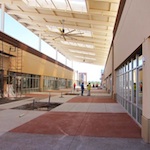At a Glance
Company headquarters
Los Angeles
Corporate employees
300
Average project duration
7.5 weeks
Current locations
210
When the now-iconic frozen yogurt chain Pinkberry opened its first store in 2005, one of its visionaries, Young Lee, set out to create what director of store development Guy Byington calls an “elegant design.” An alumnus of New York’s prestigious Parsons School of Design, Lee conceived a distinct aesthetic for the stores that has carried through the company’s expansion. “[It’s] sleek, modern, timeless, fun, and fresh,” says Byington, who joined Pinkberry a little more than a year ago—and who now helps maintain the chain’s look time and again, even when it has to fit into some interesting spaces.
“When a site is identified [for a new franchise], I’ll work with our real estate department to identify potential issues and help in determining an estimated conceptual budget for the store,” Byington says. “During that process, our store design team will assist franchise partners in a fit-out plan.”
Each store is decked out with zebra wood soffits, pebble dash flooring, and blue-and-green trellises to fit Pinkberry’s artsy, recognizable scheme. Designer elements such as lights from Le Klint, museum benches from Modernica, Noguchi tables by Herman Miller, and Nett chairs by Ton Haas are also included to enhance the chain’s clean, upscale feel. The most crucial elements of each store, of course, are the yogurt machines. Pinkberry purchases enough of them from Taylor Company to ensure all its locations can offer six unique flavors that change with the season, and it works with Concept Services for its other equipment and millwork needs.

The biggest challenges in outfitting a new store arise when the design team is working with a smaller space; it’s typically an issue in larger urban areas such as New York, in airports, and on college campuses. In these cases, the design team will sometimes have as little as 500 square feet for the yogurt machines, a toppings bar, refrigeration, storage, a manager’s desk, and customer seating.
The team has conceived a number of alternate ways to fit the store’s essentials into an allotted space. If a walk-in cooler can’t be accommodated, it uses full-height, reach-in refrigerators and adjusts the number of doors and shelves to the space. If there isn’t room for a manager’s desk in the back of the store, where it would typically go, the team looks for a place in the service area where a manager could have a workstation. And if there isn’t room to store dry ingredients (such as the sprinkles, granola, and cookie crumbs for customers to put on their yogurt), the team asks the franchise partner to look for remote storage.
All that might seem like a lot of thought, just for the sale of a frozen treat, but the efforts have made the chain’s design highly adaptable, allowing the company to expand readily and efficiently. “There’s a lot of different ways we can look at trying to implement and incorporate all of our equipment,” Byington says. “Our design team does an amazing job. They’re very creative at space planning.” ABQ
__________________________

Meet Guy Byington
Where did you go to school?
I went to San Francisco State University and graduated with a degree in economics.
What was your first construction job?
During college, I worked as a carpenter. After, I got a job at Starbucks as a barista. One thing led to another, and I got into the store management program, opening stores in the Bay Area every two or three months. [Eventually], I became a facilities manager doing remodels for Starbucks in Southern California.
How did you end up working for Pinkberry?
I was working with True Religion Brand Jeans when a recruiter called me and asked if I’d be interested in a similar position with Pinkberry. I interviewed with the company and really liked the people. I thought it would be a great fit. The company was growing and had tremendous opportunities.
What personal goals do you have in your current role?
Reduce build-out costs, shorten construction timeframes, and keep up with industry standards and technology.


